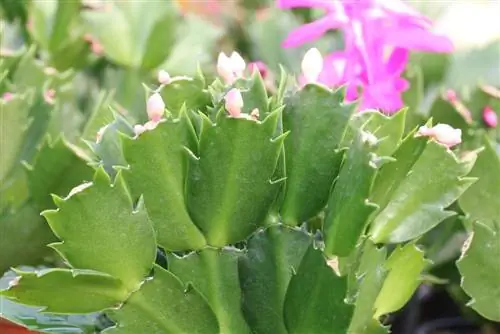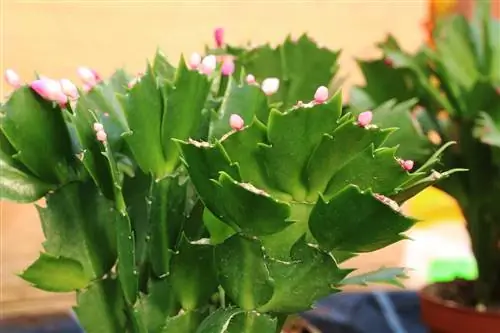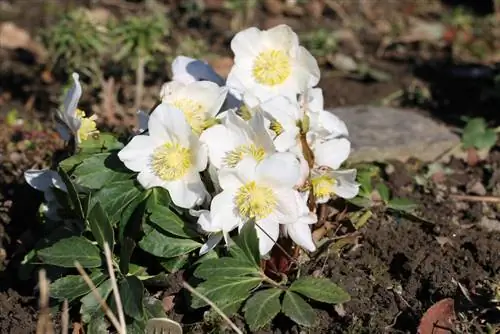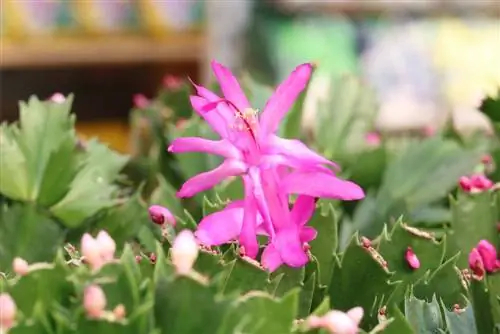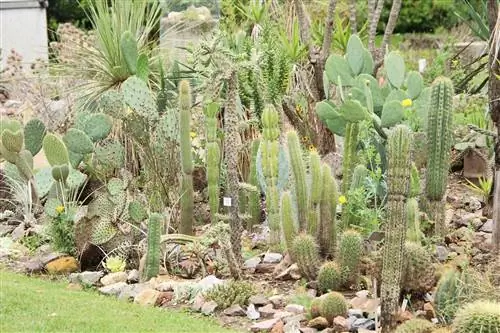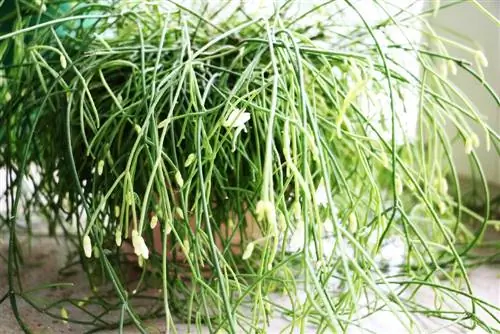- Author admin [email protected].
- Public 2023-12-17 03:39.
- Last modified 2025-01-24 12:45.
A cactus found its way to us from the tropical rainforests of Brazil, which presents its exuberant blossoms precisely at the darkest and coldest time of the year. The Christmas cactus truly lives up to its name when it outshines other houseplants as a holiday bloomer.
In order to achieve this miracle every year, a Schlumbergera truncata only needs a few, but all the more substantial, care measures. The following lines convey what these are.
Profile
- Plant family Cactaceae
- Genus Schlumbergera
- Name of the species: Christmas cactus (Schlumbergera truncata)
- thrives mainly as an epiphyte plant (epiphytic)
- native to the rainforests of Brazil
- Growth height 40 cm
- Length of the leaf segments 4-5 cm
- red, orange or white flowers from November to January
In Germany, Austria and Switzerland, the Schlumbergera truncata was named cactus of the year in 2014.
Location
The closer the light and temperature conditions are to those in its natural distribution area, the more at home the Christmas cactus feels. In the rainforests of Brazil, the plant prefers to settle on the upper branches of trees in order to get as close to the light as possible. Nevertheless, the sun's rays are filtered through the dense canopy of leaves, so that a Schlumbergera truncata is rarely exposed to direct radiation. The location should be like this:
- in the room preferably at the north or east window
- on the south window only behind filtering curtains and at a distance of 50 cm from the window glass
- Room temperatures of 18 to 25 °C are ideal
- from May to August in a partially shaded spot on the balcony or terrace
In September, the Christmas cactus begins to prepare for its winter rest. Now it moves to a cool room with temperatures of 10 to 16 °C. If it is cooler, it will not bloom.
Tip:
So that a Schlumbergera truncata blooms evenly, it is rotated by a quarter of its circumference in the window seat every week.
Humidity
As a typical inhabitant of the rainforest, the Christmas cactus requires constant humidity of 50 to 60 percent. This value is slightly higher than it is in normal living spaces. With a simple trick you can create the desired warm, humid climate in the immediate vicinity of the cactus:
- fill the coaster with pebbles and water
- place the pot on it so that it is not permanently in the water
- the liquid evaporates and envelops the epidermis with moist heat
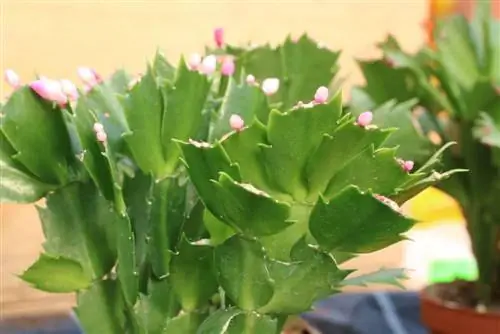
Since this effect cannot be achieved on the balcony in the open air, spray the plant repeatedly with collected rainwater. This measure is no longer necessary if the Christmas cactus receives warm summer rain from time to time.
Substrate
Good permeability is the top priority for the substrate. However, there should be a certain amount of water storage. In contrast to the hunger artists that thrive as desert cacti, the Christmas cactus requires nutrients. The plant feels comfortable in this potting soil:
- high-quality cactus soil, enriched with perlite or sand
- alternatively a mixture of humus, clay granules or vermiculite in a ratio of 3:1
The use of potting soil is delicate, given the increased risk of rot formation. Classic potted plant soil is not permeable enough, especially for cacti that spend the summer outdoors and are irrigated.
Pouring
The water supply of a Schlumbergera truncata is divided into two parts. From March to the end of August, water the cactus regularly after a thumb test. To do this, press your finger 2-3 cm deep into the substrate. If it feels dry, water thoroughly. The potting soil should dry thoroughly again before the next watering process. As a result, the pouring rhythm is as follows:
- gradually reducing the amount of irrigation water from September
- Water only enough in October to ensure that the potting soil does not dry out
- gradual increase in the amount of water as buds begin to form
- water regularly from November until the end of the flowering period, identical to the summer months
- after the end of flowering until March, limit the amount of water to the minimum
The fluctuations in the water balance shown represent - in addition to the light and temperature conditions explained - a central premise for getting the Christmas cactus to bloom.
Tip:
A Christmas cactus does not tolerate hard tap water. Therefore, only water with collected rainwater or descale the water from the tap.
Fertilize
Additional nutrients maintain the vitality of the cactus, promote growth and flowering. It is therefore recommended to pamper the plant with a special liquid fertilizer for cacti every 4 weeks from April to October. The more nutrient-rich the substrate is, the lower the dosage should be. Alternatively, water with aquarium water, which also contains the required amount of nutrients.
Repotting
After flowering is the best opportunity to transplant a Christmas cactus. Unpot the plant to inspect the root ball. If the planter is completely rooted, it is advisable to change it to a larger pot. Here's how to do it:
- Shake off the old substrate from the potted root ball.
- In the new bucket, create a drainage system made of pebbles or pottery shards above the bottom opening.
- Spread a water- and air-permeable fleece over it so that it doesn't get clogged with soil crumbs.
- Place the cactus in the middle of the pot, surround it with substrate, press down and water.
A 2-3 cm high watering edge is an advantage, as it prevents water and substrate from spilling over. Remember that the plant is in a dry phase. Pouring should therefore be kept to a minimum.
Propagate
In spring or summer, propagating a Christmas cactus is very easy to do using leaf cuttings. To do this, cut off several leaf segments with a sharp, disinfected knife and let them dry for 2-3 days. Then fill small cultivation pots with a mixture of cactus soil and sand. Insert the leaf cuttings deep enough so that they do not tip over. Ideally, you should support the cuttings with a match or toothpick.
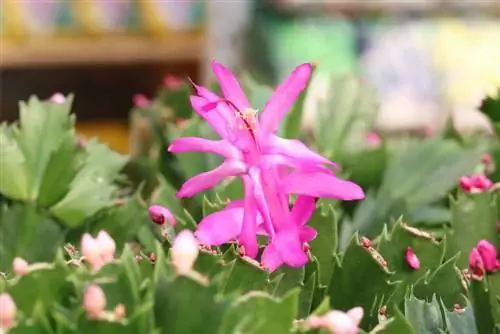
To encourage rooting, place small plastic bags over the pots. In this case, regular ventilation must be ensured due to the risk of mold formation. In a bright, not full sun location with temperatures of 22 to 26 °C, keep the cuttings constantly moist with low-lime water. A fresh shoot signals successful rooting. If the first roots poke out of the opening in the ground, repot the young plants into a larger container filled with substrate for an adult Schlumbergera truncata.
Poison content
The Christmas cactus is classified as slightly toxic. This means that it poses no danger to an adult. However, children should not come into contact with the plant as oral ingestion can cause nausea and vomiting. The same goes for pets, especially dogs, cats and rabbits, who will nibble on all green things.
Conclusion of the editors
Among the holiday bloomers, the Christmas cactus is at the top of the popularity scale. The exotic epiphyte plant makes a lasting contribution to the beautification of the Advent and Christmas season with its magnificent blooms. If you give a Schlumbergera truncata proper care, you can look forward to this impressive natural wonder for many years to come. In order for this to be successful, an exact rhythm must be followed in terms of light and temperature conditions as well as in the water and nutrient supply.
What you should know about the Christmas cactus in brief
- The Christmas cactus originally comes from Brazil. The plant is mainly available for purchase in the run-up to Christmas.
- The flower color ranges from white to yellow to strong red and pink tones.
- The leaves, which grow in limbs, are slightly toothed at the edges (this is a noticeable difference from the Easter cactus).
- The Christmas cactus is actually very easy to care for, as long as you follow a few basic rules.
- The location should be bright to partially shaded, but without direct sun.
- When purchasing, make sure to buy the plants from a store that has similar lighting conditions as your future home.
- After the first buds appear, the plant should not be moved for this reason.
Tip:
A particularly lush flowering can be expected if the plant is kept a little cooler about 3 months before the desired flowering. The lighting conditions should remain the same as possible. During this time the Christmas cactus is watered very sparingly.
- Only when the first buds appear can you start with regular watering.
- Once the flowers have faded again, give the Christmas cactus 4-6 weeks of rest.
- For watering, only soft water should be used, e.g. condensation from the dryer, unless you use fabric softener.
- Fertilization is carried out once a month with a 0.1% fertilizer solution.
- The plant is repotted after flowering or well before the buds form.
- A slightly acidic substrate with a pH value of 5.0 to 6.0 is suitable as soil.
- The Christmas cactus is prone to root rot. This disease usually occurs when the substrate is too cold - you should pay attention to soil heat.
Tip:
Propagation occurs by cutting off leaf sections. These are then placed in a pot filled with substrate and rooted at a soil temperature of around 20 degrees Celsius. Always make sure that the soil is slightly moist. The Christmas cactus is very easy to care for and is not susceptible to diseases and pests.

